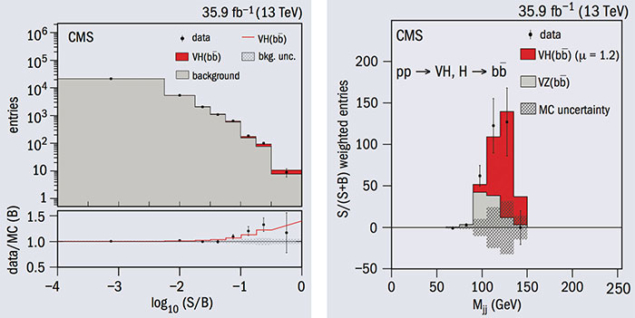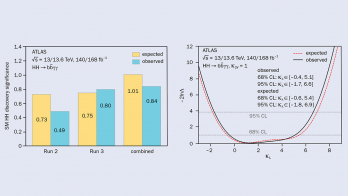
The CMS experiment has added another piece to the Higgs boson puzzle, reporting evidence that the Higgs decays to a pair of b quarks.
In the Standard Model (SM) the Higgs field couples to fermions, giving them their masses, through a Yukawa interaction. The recent CMS observation of the H → ττ channel provides direct evidence of this interaction. While it is clear that the Higgs boson couples to up-type quarks (based on overall agreement between the gluon–gluon fusion production channel cross-section and the SM prediction), the Higgs boson decay to bottom quark–antiquark pairs provides a unique tool to directly access the bottom-type quark couplings.
The Higgs boson decays to a pair of b quarks 58% of the time, making it by far the most frequent decay channel. However, at the LHC the signal is overwhelmed by QCD production, which is several orders of magnitude higher. This makes the H → bb process very elusive. The most effective way to observe it is to search for associated production with an electroweak vector boson (VH, with V being a W or a Z boson). Further background reduction is achieved by requiring the Higgs boson candidates to have large transverse momentum and by exploiting the peculiar VH kinematical event properties.
The latest CMS analysis is based on LHC data collected last year at an energy of 13 TeV. To identify jets originating from b quarks, the collaboration used a novel combined multivariate b-tagging algorithm that exploits the presence of soft leptons together with information such as track impact parameters and secondary vertices. A signal region enriched in VH events was then selected, together with several control regions to test the accuracy of the Monte Carlo simulations, and a simultaneous binned-likelihood fit of the signal and control regions used to extract the Higgs boson signal.
An excess of events is observed compared to the expectation in the absence of a H → bb signal. The significance of the excess is 3.3σ, where the expectation from SM Higgs boson production is 2.8σ. The signal strength corresponding to this excess, relative to the SM expectation, is 1.2±0.4. When combined with the Run 1 measurement at a lower energy, the signal significance is 3.8σ with 3.8σ expected and a signal strength of 1.1.
To validate the analysis procedure, the same methodology was used to extract a signal for the VZ process, with Z → bb, which has a nearly identical final state but with a different invariant mass and a larger production cross-section. The observed excess of events for the combined WZ and ZZ processes has a significance of 5σ from the background-only event-yield expectation, and the corresponding signal strength is 1.0±0.2.
Thanks to the outstanding performance of the LHC, the data set will significantly increase by the end of Run 2, in 2018. This will allow a consistent reduction of the uncertainties, and a 5σ observation of the H → bb decay is expected.
Further reading
CMS Collaboration 2017 arXiv:1709.07497.








